We arrived at the hostel, checked in, & found our room, all the while exclaiming over how much better than the Generator this place was! (It was rather nice: a hostel, sure, but clean! And cute, and quirky, & friendly.)
So we had the party in the hostel room, later joined by Katie Manteca! All the way from London.
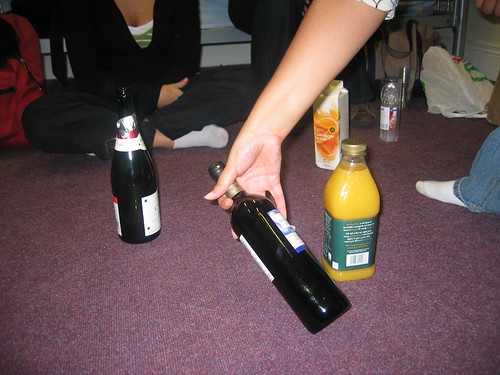
I'm warning you: this post is going to be full of photos, & probably of historical rambling. (For the real historical stuff, you really should go look it all up--it's fascinating, & I certainly don't remember exact dates or everything they told me. But it's good to know.)
We woke up ludicrously early on Saturday in order to go on a Paddywagon day tour. Our morning walk to the bus stop was made slightly better by passing near the gorgeous campus of Queen's University:
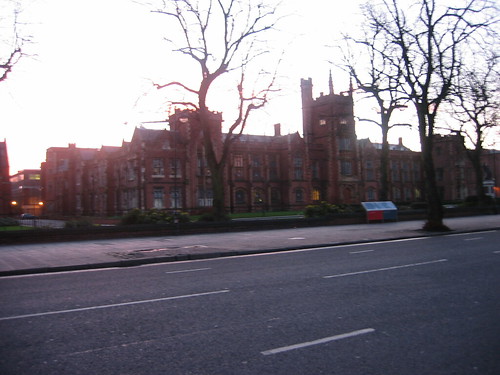
We grabbed breakfast and hung around the Paddywagon, which was a short little bus painted bright green with a leprechaun on it. Our bus driver showed up, boarded us all onto the bus along with the other waiting (& cold) passengers, and began to drive through Belfast to pick up others. Along the way Rachel and Katie Rice, & Rachel's friend Sarah, who had all come all the way up from Dublin that morning, joined us on the tour.
Our driver was hilarious. I wish, now, that I'd gotten some video just so I could show you a taste of how fantastic he was. He spent the whole time in Belfast singing (Black Velvet Band, Tell Me Ma, some others) or whistling or doodel-doodley-do-ing or somesuch. His name was Joseph Patrick Mulligan, "but you can call me Joey." He told us about pieces of history, random anecdotes. How St Patrick went to France to study Christianity, & while he was there he began to hear voices: "You ever hear voices? ... You ever hear them? No? I do. Round about four in the afternoon, I start hearin' em.... Guinness! Guinness! Buy a Guinesss! ...I'm startin' to hear em in the morning too. Well, Patrick was hearing these voices... Patrick...Patrick! Come back to Ireland, Patrick! Get your ass back here! ...cheap flights. Just pay all your taxes. ryanair.com." At one point, as we were rattling along Irish roads, Nora said, "We're going to die, & it's going to be hilarious!"
Our first stop was where the Carrick-a-Rede rope bridge would be, were it not past October--in winter it's far too windy to have it up from the mainlaind out to the island. The Antrim coast that we were driving along is gorgeous, though, rope bridge or no rope bridge.
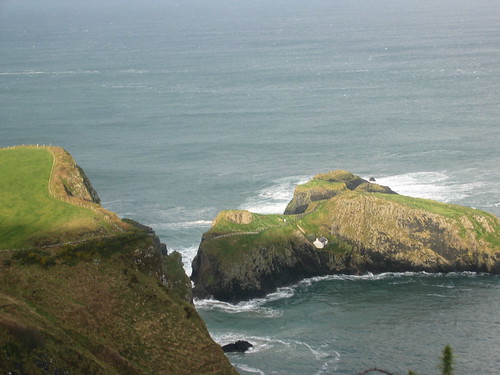

Look to the upper left in this photo, along above the fence line. See that land mass in the mist? Yeah. That's Scotland. Only 24 miles away!
We got back in the bus, shivering and swearing at the cold, and Joey took us the rest of the way to Giant's Causeway. It was breathtaking--partly because of the incredible natural beauty of the coast & the bizarrity of the rock formations, & partly because it was so fecking cold it was hard to breathe at all.
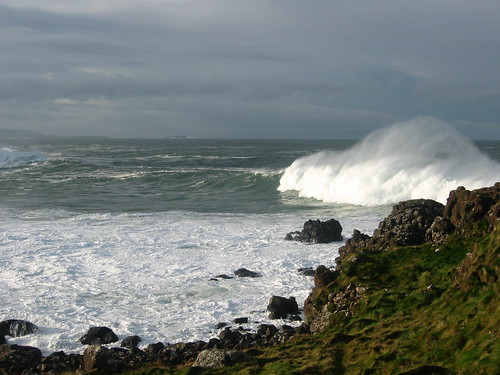
(The waves were enormous, & when they reached the shore the wind was so high and fast that it sent ocean foam skidding all up into the air like it was snowing.)
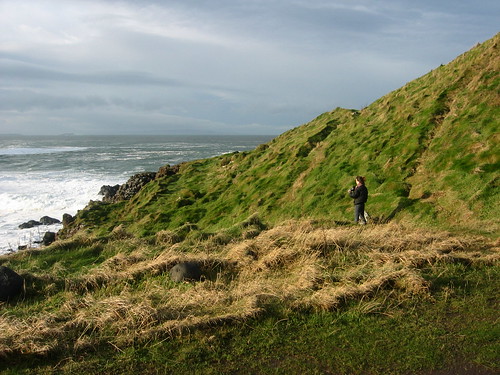
(Katie Rice, against a backdrop of what the winter sun can do to an Irish landscape.)
The Giant's Causeway proper is a spit of land that's made of (mostly) hexagonal pillars of rock, created either from magma lakes under Panagea, or by Finn McCool, depending on whom you ask. Either way, it's pretty good fun:

But you have to be careful of going too far out toward the ocean, because Irish waves have no mercy:
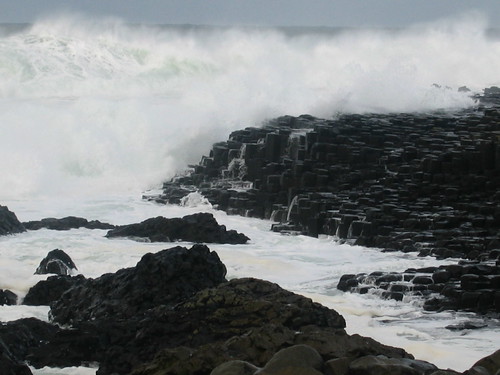

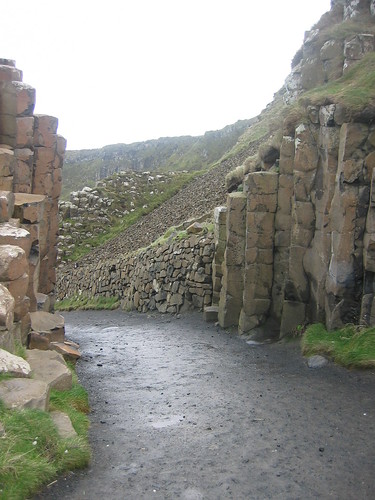
(The Giant's Gate.)
We warmed up with some soup and tea, and then piled back onto the bus to drive to Derry, just as the rain began. This is where my other major will take over now, and all the historical stuff will come pouring out. I knew some about the conflict in Northern Ireland, and a little about Bloody Sunday and the civil rights marches in Derry, mostly from seeing Joel's Carthaginians & then doing a monologue from it for Amanda. But I learned a whole hell of a lot more when I was there, even in two hours. And when you're standing on the very spot that something happened, being told about it by a Derry citizen, it becomes much more real than textbooks can tell you. I'll try, though. Now, this is going to be a lot of history. If you just want pretty pictures, scroll down a bit. But I'm going to give some context first, most of it learned from a walking tour of the Bogside area, led by a local man named Mickey.
Most of the people who talked about the conflict in Derry began in 1689 (no, stay with me), when the siege of Derry began. Northern Ireland had been colonized by British Protestants years before (remember Oliver Cromwell?), but in 1689, James II (a Catholic) and William of Orange (a Protestant) were in battle over the crown. James began a siege on Derry, but the Protestants living within the walls shut the gates and endured over 100 days of siege until William came to their rescue. The Protestants, understandably, are quite proud of this victory. More or less from that time until the late 20th century, in Derry, as in much of Northern Ireland, the Unionists (Protestants loyal to Britain, wanting to keep NI part of the UK) were in political power, though not necessarily in the majority.
In the late 20th century, civil rights marches began in Derry, over the treatment of the Catholic citizens of the city. Loyalists (Unionists) lived inside the walls; Nationalists (Catholics) lived outside the walls, in rented houses, unable to buy their own land or home. If you weren't a homeowner, you weren't allowed to vote; and so by gerrymandering the Unionists had control of Derry. In 1968 a civil rights movement began, over housing conditions and the right to vote. This Wikipedia article goes more in depth than I can. All you need to know at this point is that most of the marches, and therefore counter-protests, riots, and violence, centered around Bogside, one of the Catholic housing areas just outside the walls of Derry. When the local police failed to protect the marchers, the British Army was called in; in fact it wasn't until a year or so later that they really became the enemy. Eventually this gave rise to the IRA (Irish Republican Army), and the violence continued--petrolbombs, tear gas, rioting.
All around Free Derry (a declared zone, which Bogside is a part of) are murals representing their history.
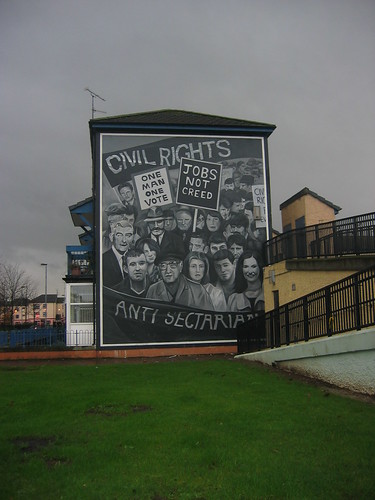

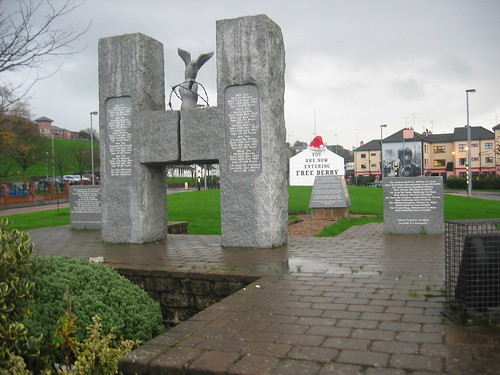
The monument in the front is in the shape of the H-block prisons that nationalist and IRA prisoners were kept in. It's a monument to the blanket strikes, shit strikes and hunger strikes, and the ultimate success in keeping those prisoners political prisoners rather than criminal, as Margaret Thatcher was attempting to do. (Criminalizing the prisoners would have meant that the IRA was a local criminal gang, & not Britain's problem; by keeping it political, it kept Britain implicated.) The H monument is broken, slightly, in the middle, to symbolize the breaking of the criminalization attempt. In the background you can see the wall--the only real Derry wall, according to Mickey.
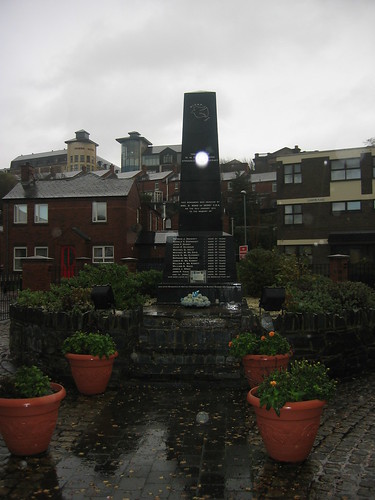
And this is the monument to Bloody Sunday.
Bloody Sunday was in 1972. 14 civil rights marchers were shot dead by the British Army. The worst part, according to Mickey, was not necessarily the shooting but the fact that the Brits said they had shot armed insurgents, in self defense. In fact no one was firing on the army. "One man," Mickey said, "was standing right there (& he gestured across the road), trying to help a victim, waving a white handkerchief--and he was shot in the head so closely that his eyebrow stuck to the wall right there. My dad used to work with him." What can you say to that? It's realer than I can possibly write about here.


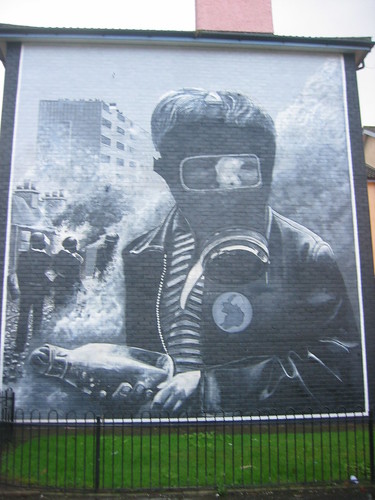
The adventure wasn't over. Joey drove us up into town, and reminded us of something Mickey had said. The day we were there, the Apprentice Boys' Guild, a group in the Orange Order (a Protestant, Unionist fraternity) was having an annual march, having to do with the Siege (the apprentice boys were the first to shut the gates), and a traitor named Lundy. Every year they have a march, & then burn an effigy of Lundy--like Guy Fawkes, but less jolly. Previously they would march on the walls of Derry above Bogside, and it would incite riots; now the parades are more or less peaceful. Joey dropped us off on Shipquay street and said we could walk around Derry, watch the parade if we wanted. Well, it was freezing, and raining, but did we ever want to watch it! So some of us ran up the hill to the town and stood behind barricades and policemen to watch the Orange order go by.
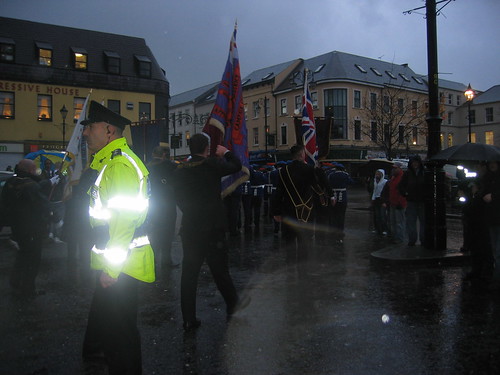
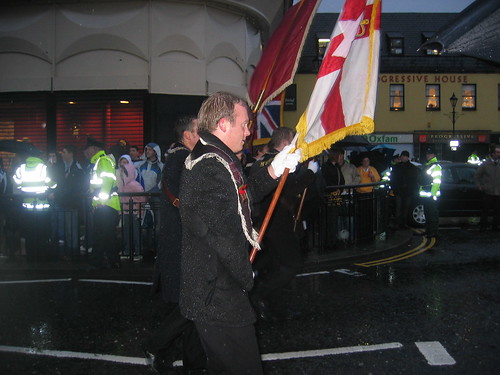
We ducked into a nearby shopping centre after it had gone by, to get a bit warmer. Rachel, Katie Rice and I wanted to go find a way to walk on the walls of Derry, so we braved the rain again. As we were crossing the street the parade had turned up, we saw that the air was all smoky and the street was blocked off by a full line of police. I'd forgotten about the burning of the effigy of Lundy, but there we were with a reminder:
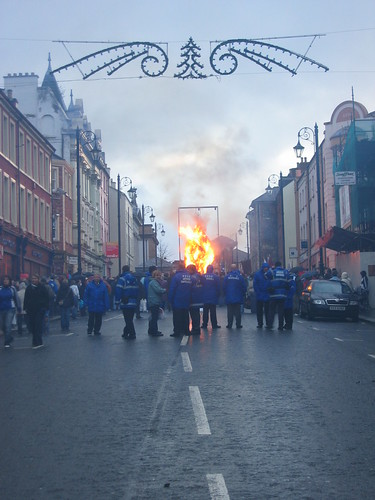
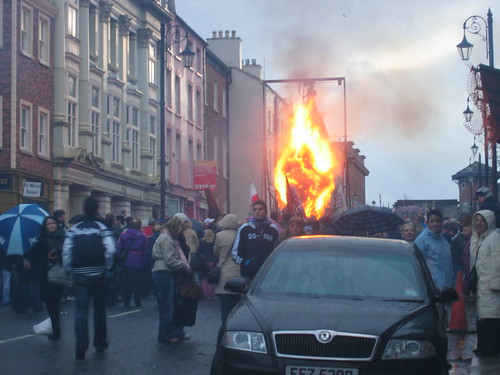
(There it is closer, the shape of a hanged man.)
The police were quite friendly, and let us through to go look at the fire. Turning around, this is what the line looked like from behind. The bits of floating black in the picture are pieces of Lundy that were flying around. I got effigy in my eye.
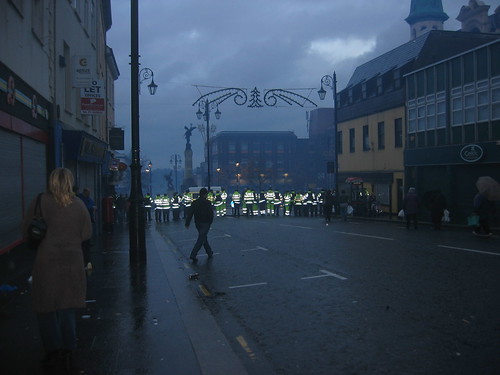
We continued on, and found a ramp up to the walls of Derry, which are fourteen feet thick and rather tall, all the way around the medieval town (traditionally nationalists never went inside; the division is less so now). When we got up onto the walls we saw policemen in black riot gear, with full helmets on--nothing like the fairly laid back guards in the streets. The first one we saw didn't seem to stop us, so we continued, figuring that was just par for the course? Until a second one did stop us, and told us, You'd better get off the walls, there's people with petrolbombs down there. So we got off the walls, stat, and scurried back into town, eyes wide. We managed to find another wall entrance, onto a part of the walls that weren't overlooking the Bogside and didn't have riot-dressed policemen on them, so at least we did get to walk the walls. Without the danger of petrolbombs.
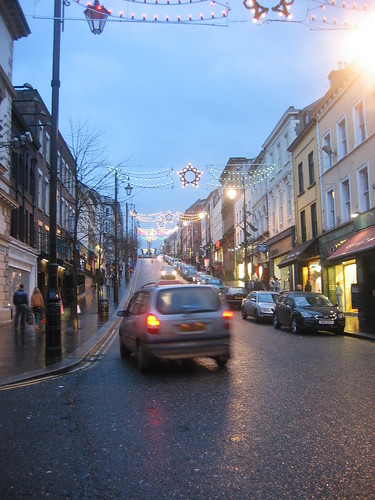
One last look up Shipquay street.
And I'm quite tired, & making more typos than it's worth correcting at this point. I'll just let Day 1 be for now, & put up Day 2 (in Belfast itself) tomorrow.
Peace.
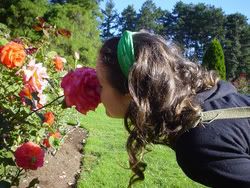
No comments:
Post a Comment